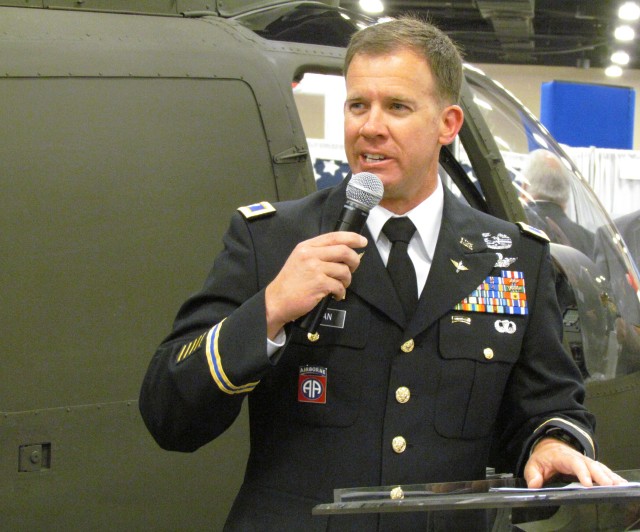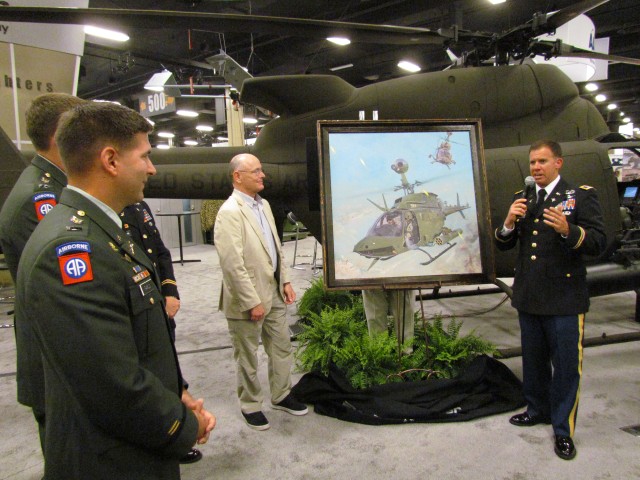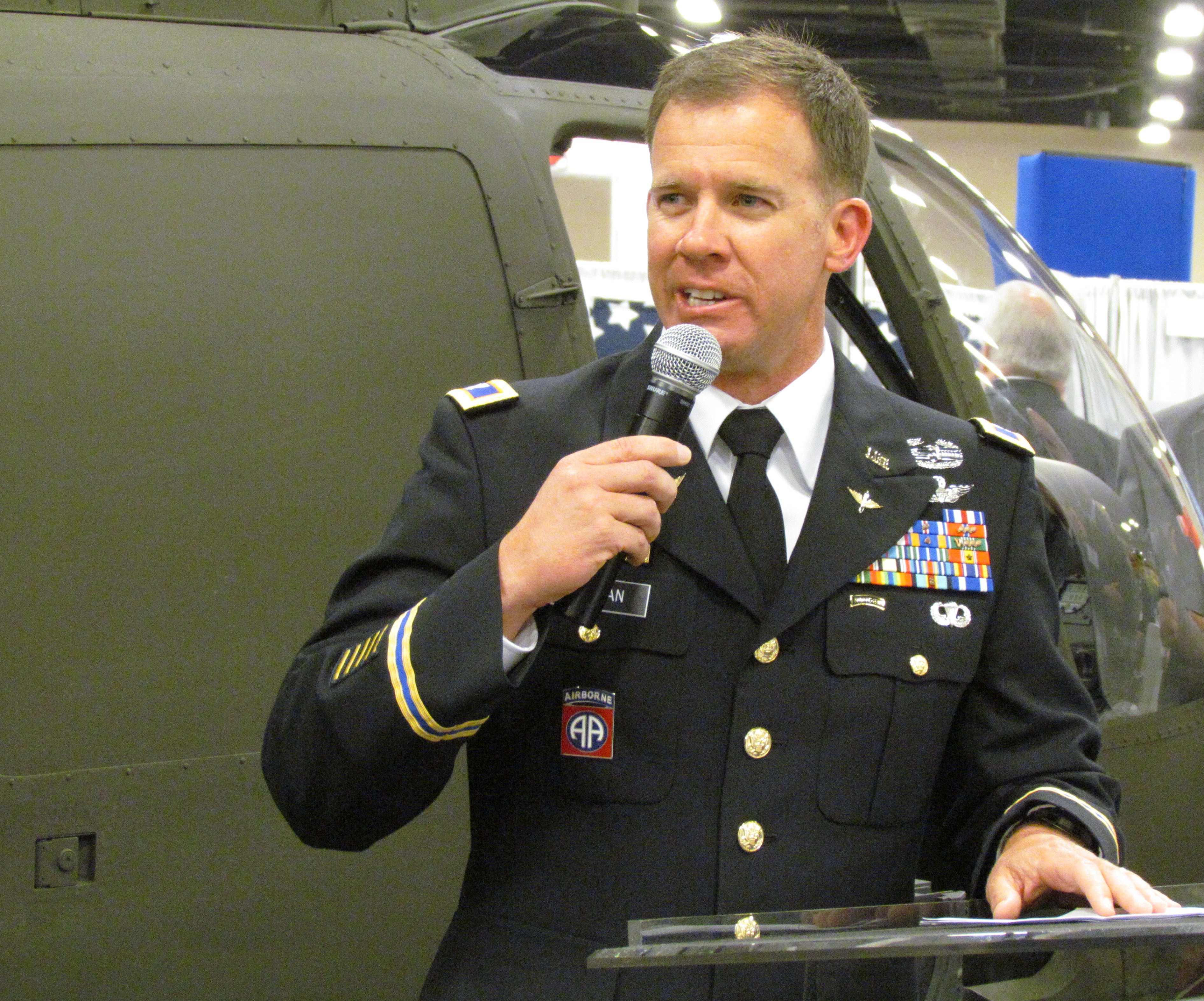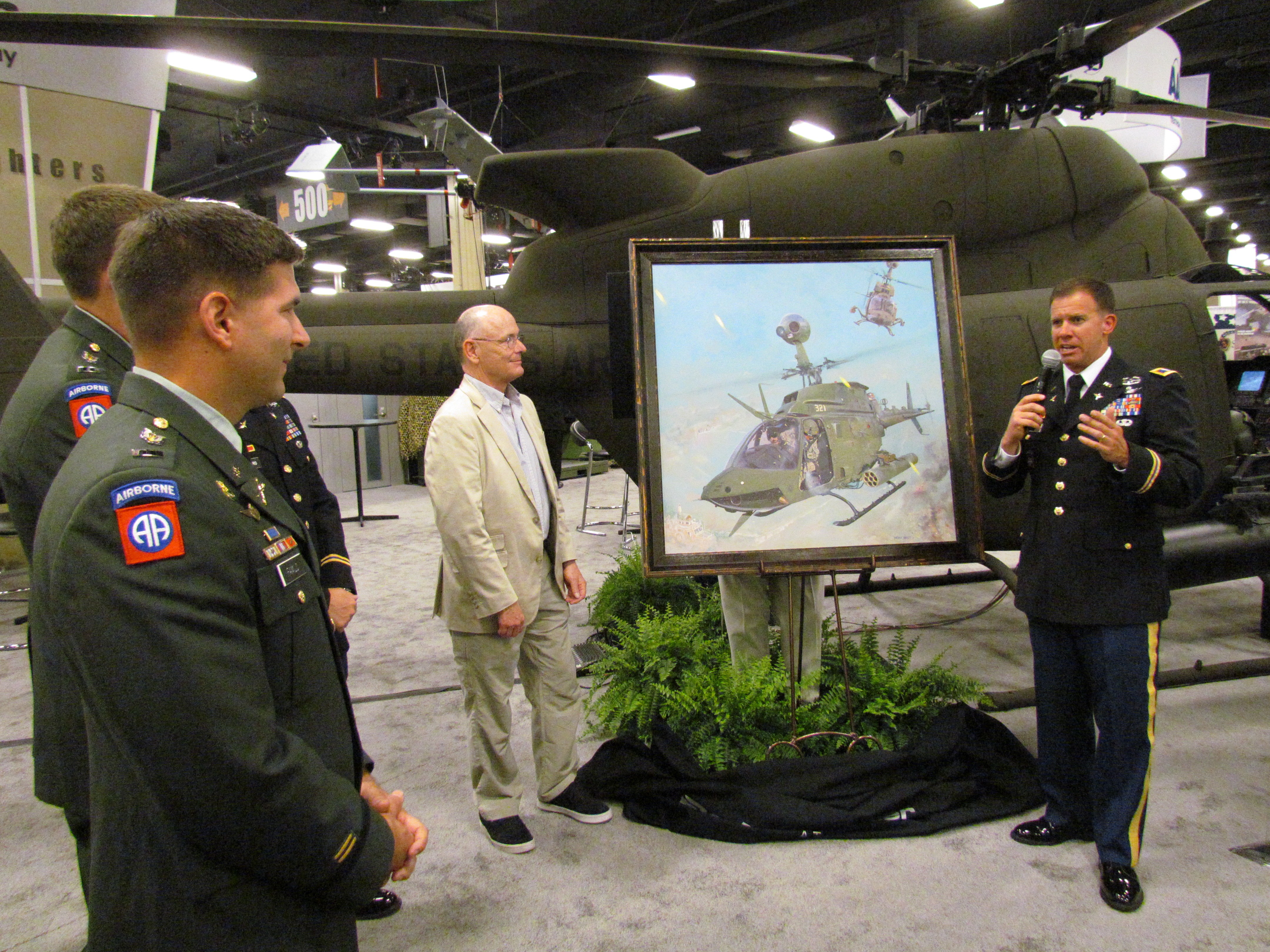REDSTONE ARSENAL, Ala.--In words that rang with deep emotion, Col. Mike Morgan admitted he doesn't talk much about the actions behind the Silver Star that Defense Secretary Robert Gates clipped on his desert camouflage uniform in Afghanistan a year ago in March.
He rarely tells his wife or his parents about the threat he and his OH-58 Kiowa Scout Weapons Team faced this time two years ago when they came to the aid of U.S. Soldiers ambushed while working to clear bombs from a road outside Kandahar in southern Afghanistan.
But during the Army Aviation Association of America annual Professional Forum and Exposition in Nashville, he shared his story for the first time with an audience gathered at the Bell Helicopter exhibit so they could understand the teamwork represented by a new painting by artist Patrick Haskett that depicts Morgan's Kiowa and his Kiowa wingman during the battle. The painting, unveiled following his comments, was dedicated to Morgan's team by Bell Helicopter, which manufactured the Army's fleet of Kiowa helicopters. It will hang in the 82nd All-American Airborne Division Museum at Fort Bragg, N.C.
"Even though Chief Warrant Officer 2 (Toby) Familo, Capt. (Anthony) Fuscellaro, and Chief Warrant Officer 2 (Adam) Fletcher's valorous acts are captured in this painting, more importantly they represent the professionalism, commitment and mission focus, which are genuine characteristics of the professionals which fill the ranks of Army aviation," Morgan said.
"When I think about this painting I think about what it represents more than the specific actions units are engaged in during the course of a deployment. I think of the entire team -- the team of Task Force Saber, and their work with coalition ground forces."
The OH-58 Kiowa, nicknamed the Army's Scout helicopter, and its pilots are known for spirited actions in battle that draw attention away from ground forces. They can get in "danger close" to the enemy, and are known for being the first to make contact with the enemy and the last to leave.
"When I think of this conflict, this battle ... We had our opportunity and time and space to influence the battle. Many others have shown bravery as well," Morgan said.
Pilots Familo, Fuscellaro and Fletcher, who were also at the unveiling ceremony, were part of the Task Force Saber team led by Morgan, then a lieutenant colonel, during their April 2009-April 2010 deployment in Operation Enduring Freedom-Afghanistan, where they were tasked with around-the-clock reconnaissance and security missions. Task Force Saber was an armed reconnaissance task force comprised of 425 pilot, maintenance and support Soldiers, 24 Kiowa Warriors, nine Apaches, two direct support Black Hawks and a Pathfinder Company from the 1st Squadron, 17th Cavalry Regiment, 82nd Combat Aviation Brigade, 82nd Airborne Division. They facilitated aviation operations for Regional Command South in Afghanistan's Kandahar Province.
"The environment in Kandahar was perfect for an armed reconnaissance task force. The terrain is characterized by the urban sprawl of Kandahar, the outlying villages connecting the nomadic indigenous population of Afghanistan, and the high mountain desert expanses," Morgan said. "The villages surrounding Kandahar are characterized by interconnected primary and secondary dirt roads, deep vegetated wadi systems (dry riverbeds), and mud one-story structures in the most populated areas."
Task Force Saber provided air support for route clearance patrols of the 4th Engineer Battalion that facilitated freedom of movement within the Kandahar province. One particular area, known as Howz-e-Maded, was a Taliban stronghold notorious for improvised explosive devices, small arms fire, and direct and indirect attacks on coalition forces.
"Late spring marked the end of the poppy season, and effectively returned the Taliban to focus on fighting," Morgan said. "June and July were filled with small engagements throughout the area of operations, and intelligence was hinting toward a large scale coordinated attack. One of those attacks came on 24 April 2009."
On that day, the 4th Engineers identified an IED on a road known as Highway 1 just east of Howz-e-Madad. They followed the IED's command wire, not knowing it was an attempted ambush.
"The initial insurgent response appeared to reveal approximately 20 insurgents. What evolved was nearly 100 insurgents who were using interconnected, pre-prepared, concealed and covered positions by leveraging the wadi systems, mud buildings and dense tree coverage," Morgan said. "They were armed with AK-47s, RPGs (rocket propelled grenades), and PKM (machine guns) primarily, and their closest positions were within 20 meters of the MRAP (the engineer unit's lead Mine Resistant Ambush Protected vehicle stopped on the highway) and 100 meters from the 4th Engineer support-by-fire position (on a rooftop)."
Morgan and his OH-58D Kiowa two-unit Scout Weapons Team arrived on the scene as the engineer unit was pursuing the source of the small arms fire, which was actually a baited ambush.
"We could hear the urgency in the voice" and the "tremendous pressure and stress on the battlefield" through the radio messages received from ground forces, Morgan said.
"They were fighting for their lives and looking for any help they could get."
Although the standard response to small arms fire was to bypass and continue along the way, in this situation the engineering unit's platoon leader headed straight for the enemy fire "because he was tired of being shot at. The rhythm of the battle was building," the colonel recalled.
As enemy fire increased, Morgan's team was called in to deliver rocket and .50-caliber machine gun fire onto the insurgents.
"Upon delivering the first pair of rockets into the insurgents, machine gun, RPG, and small arms erupted from multiple locations within 200 meters of the ground force," Morgan said. "The fire was aimed at both the engineers and the aircraft, and the engineers returned high volumes of fire while the aircraft continued a hard break to come around for another engagement ... Unlike previous engagements, the insurgents were reinforcing instead of breaking contact. This was new to us."
Although the ground forces and the two Kiowa helicopters neutralized the most dangerous enemy machine gun positions, the engineer unit's lead MRAP with a four-man team was still receiving heavy small arms fire from the enemy machine gun emplacement located 20 meters away.
"The squad leader relayed that they were still in the kill zone and were unable to turn their vehicle back to the north due to the deep wadis on either side of the road. They required a ground guide to make the turn, and it was evident to the enemy that the lead vehicle was stranded," Morgan said.
Though the Kiowas no longer had ammunition, they entered the area twice on a low and slow profile.
"Everybody in the cockpit was all in and the ground forces were as well. They had no choice and we didn't either," Morgan said.
The two Kiowas distracted the enemy fire so that a ground guide could dismount and direct the MRAP in its turn so that it could leave the kill zone. The co-pilots were only able to fire their M4 rifles from the cockpit to engage the enemy and protect the Kiowas from enemy fire.
An excerpt from the narrative that accompanied Morgan's Silver Star reads: "His heroic actions and those of the aircrews he led were singularly responsible for saving American lives that were on the brink of being overrun by determined enemy insurgents of numerically superior force. Lt. Col. Morgan's quick reaction, skillful employment of his and other attack weapon systems, and mastery coordinating multiple aircraft over a target simultaneously resulted in a confirmed three insurgents killed and an estimated 20-30 unconfirmed.
"Lt. Col. Morgan, with his aircraft munitions expended, determined that American lives were at risk. He quickly decided to make two additional direct passes with his team, enabling his co-pilots to use their M4 rifles to suppress insurgents attempting to maneuver and overtake the pinned down route clearance team lead vehicle. His actions provided critical time and space to enable the vehicle to maneuver out of the kill zone and back to the north."
For six hours that day, "the Scout weapons teams, attack aircraft, engineers and artillery worked seamlessly as one team. The Taliban intelligence gained during this battle led to operations by coalition forces which would turn the tide on this stronghold," Morgan said. "More importantly the teamwork displayed in this battle and throughout the tour enabled aviation assets to provide nonstop armed reconnaissance in support of Kandahar's coalition ground forces."
Twice, Morgan's Scout Weapons Team, relieved by other Kiowa teams, had to return to the Forward Arming and Refueling Point for refueling and re-arming, and then returned to the fight.
Although helicopter pilots are often the front-line heroes recognized for being game changers in battle situations, Morgan emphasized the importance of the personnel and aviation maintainers stationed at Forward Arming and Refueling Points in war zones for setting "the conditions for every operation. These great troopers sacrifice often and rarely see the front lines."
He also thanked the aviation enterprise - the Aviation and Missile Command, the Program Executive Office for Aviation, project management, logistics support and industry partners - for making a difference as the "team behind the team."
"They always ensure the forces on the front lines have everything they need to accomplish the mission," Morgan said.
Morgan also thanked the artist - Army Korean War veteran Patrick Haskett - for a painting that is representative of all Kiowa teams.
"The action portrayed in this painting represents one of the many performed by the troopers I was honored to serve alongside," he said. "There were many heroes on the ground and in the air during this tour, and Patrick Haskett's art is representative of the entire team that it takes to succeed on today's modern battlefields."
Besides the Silver Star, which is the third highest military decoration for valor in battle, Morgan also received two Distinguished Flying Crosses and an Army Commendation Medal with Valor for his actions on April 24, 2009. Morgan, whose 22 years in uniform has included seven deployments to Iraq or Afghanistan, is attending the Air Force War College at Maxwell Air Force Base in Montgomery and, upon graduation, will take command of the 1st Infantry Division's combat aviation brigade at Fort Riley, Kan.




Social Sharing